数字信号处理上机实验报告
《数字信号处理》实验报告

《数字信号处理》上机实验指导书一、引言“数字信号处理”是一门理论和实验密切结合的课程,为了深入地掌握课程内容,应当在学习理论的同时,做习题和上机实验。
上机实验不仅可以帮助学生深入地理解和消化基本理论,而且能锻炼初学者的独立解决问题的能力。
所以,根据本课程的重点要求编写了四个实验。
第一章、二章是全书的基础内容,抽样定理、时域离散系统的时域和频域分析以及系统对输入信号的响应是重要的基本内容。
由于第一、二章大部分内容已经在前期《信号与系统》课程中学习完,所以可通过实验一帮助学生温习以上重要内容,加深学生对“数字信号处理是通过对输入信号的一种运算达到处理目的” 这一重要概念的理解。
这样便可以使学生从《信号与系统》课程顺利的过渡到本课程的学习上来。
第三章、四章DFT、FFT是数字信号处理的重要数学工具,它有广泛的使用内容。
限于实验课时,仅采用实验二“用FFT对信号进行谱分析”这一实验。
通过该实验加深理解DFT的基本概念、基本性质。
FFT是它的快速算法,必须学会使用。
所以,学习完第三、四章后,可安排进行实验二。
数字滤波器的基本理论和设计方法是数字信号处理技术的重要内容。
学习这一部分时,应重点掌握IIR和FIR两种不同的数字滤波器的基本设计方法。
IIR滤波器的单位冲激响应是无限长的,设计方法是先设计模拟滤波器,然后再通过S~Z平面转换,求出相应的数字滤波器的系统函数。
这里的平面转换有两种方法,即冲激响应不变法和双线性变换法,后者没有频率混叠的缺点,且转换简单,是一种普遍应用的方法。
学习完第六章以后可以进行实验三。
FIR滤波器的单位冲激响应是有限长的,设计滤波器的目的即是求出符合要求的单位冲激响应。
窗函数法是一种基本的,也是一种重要的设计方法。
学习完第七章后可以进行实验四。
以上所提到的四个实验,可根据实验课时的多少恰当安排。
例如:实验一可根据学生在学习《信号与系统》课程后,掌握的程度来确定是否做此实验。
若时间紧,可以在实验三、四之中任做一个实验。
数字信号处理实验报告
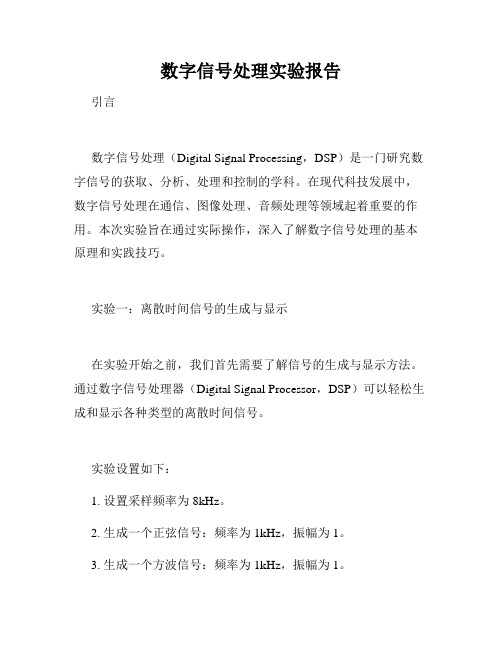
数字信号处理实验报告引言数字信号处理(Digital Signal Processing,DSP)是一门研究数字信号的获取、分析、处理和控制的学科。
在现代科技发展中,数字信号处理在通信、图像处理、音频处理等领域起着重要的作用。
本次实验旨在通过实际操作,深入了解数字信号处理的基本原理和实践技巧。
实验一:离散时间信号的生成与显示在实验开始之前,我们首先需要了解信号的生成与显示方法。
通过数字信号处理器(Digital Signal Processor,DSP)可以轻松生成和显示各种类型的离散时间信号。
实验设置如下:1. 设置采样频率为8kHz。
2. 生成一个正弦信号:频率为1kHz,振幅为1。
3. 生成一个方波信号:频率为1kHz,振幅为1。
4. 将生成的信号通过DAC(Digital-to-Analog Converter)输出到示波器上进行显示。
实验结果如下图所示:(插入示波器显示的正弦信号和方波信号的图片)实验分析:通过示波器的显示结果可以看出,正弦信号在时域上呈现周期性的波形,而方波信号则具有稳定的上下跳变。
这体现了正弦信号和方波信号在时域上的不同特征。
实验二:信号的采样和重构在数字信号处理中,信号的采样是将连续时间信号转化为离散时间信号的过程,信号的重构则是将离散时间信号还原为连续时间信号的过程。
在实际应用中,信号的采样和重构对信号处理的准确性至关重要。
实验设置如下:1. 生成一个正弦信号:频率为1kHz,振幅为1。
2. 设置采样频率为8kHz。
3. 对正弦信号进行采样,得到离散时间信号。
4. 对离散时间信号进行重构,得到连续时间信号。
5. 将重构的信号通过DAC输出到示波器上进行显示。
实验结果如下图所示:(插入示波器显示的连续时间信号和重构信号的图片)实验分析:通过示波器的显示结果可以看出,重构的信号与原信号非常接近,并且能够还原出原信号的形状和特征。
这说明信号的采样和重构方法对于信号处理的准确性有着重要影响。
《数字信号处理》上机实习报告
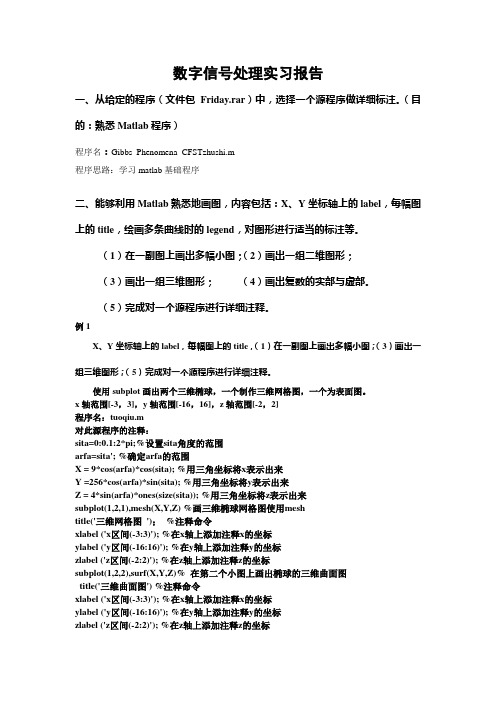
数字信号处理实习报告一、从给定的程序(文件包Friday.rar)中,选择一个源程序做详细标注。
(目的:熟悉Matlab程序)程序名:Gibbs_Phenomena_CFSTzhushi.m程序思路:学习matlab基础程序二、能够利用Matlab熟悉地画图,内容包括:X、Y坐标轴上的label,每幅图上的title,绘画多条曲线时的legend,对图形进行适当的标注等。
(1)在一副图上画出多幅小图;(2)画出一组二维图形;(3)画出一组三维图形;(4)画出复数的实部与虚部。
(5)完成对一个源程序进行详细注释。
例1X、Y坐标轴上的label,每幅图上的title,(1)在一副图上画出多幅小图;(3)画出一组三维图形;(5)完成对一个源程序进行详细注释。
使用subplot画出两个三维椭球,一个制作三维网格图,一个为表面图。
x轴范围[-3,3],y轴范围[-16,16],z轴范围[-2,2]程序名:tuoqiu.m对此源程序的注释:sita=0:0.1:2*pi;%设置sita角度的范围arfa=sita'; %确定arfa的范围X = 9*cos(arfa)*cos(sita); %用三角坐标将x表示出来Y =256*cos(arfa)*sin(sita); %用三角坐标将y表示出来Z = 4*sin(arfa)*ones(size(sita)); %用三角坐标将z表示出来subplot(1,2,1),mesh(X,Y,Z) %画三维椭球网格图使用meshtitle('三维网格图');%注释命令xlabel ('x区间(-3:3)'); %在x轴上添加注释x的坐标ylabel ('y区间(-16:16)'); %在y轴上添加注释y的坐标zlabel ('z区间(-2:2)'); %在z轴上添加注释z的坐标subplot(1,2,2),surf(X,Y,Z)% 在第二个小图上画出椭球的三维曲面图title('三维曲面图') %注释命令xlabel ('x区间(-3:3)'); %在x轴上添加注释x的坐标ylabel ('y区间(-16:16)'); %在y轴上添加注释y的坐标zlabel ('z区间(-2:2)'); %在z轴上添加注释z的坐标运行结果:例2绘画多条曲线时的legend,对图形进行适当的标注等。
数字信号处理上机报告
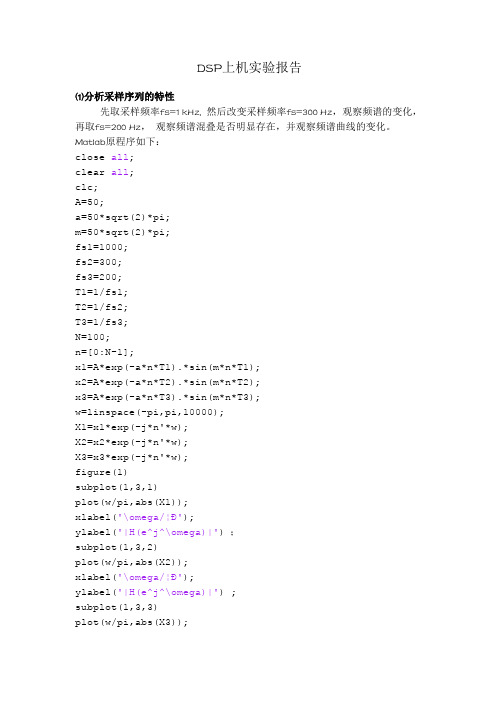
DSP上机实验报告(1)分析采样序列的特性先取采样频率fs=1 kHz, 然后改变采样频率fs=300 Hz,观察频谱的变化,再取fs=200 Hz,观察频谱混叠是否明显存在,并观察频谱曲线的变化。
Matlab原程序如下:close all;clear all;clc;A=50;a=50*sqrt(2)*pi;m=50*sqrt(2)*pi;fs1=1000;fs2=300;fs3=200;T1=1/fs1;T2=1/fs2;T3=1/fs3;N=100;n=[0:N-1];x1=A*exp(-a*n*T1).*sin(m*n*T1);x2=A*exp(-a*n*T2).*sin(m*n*T2);x3=A*exp(-a*n*T3).*sin(m*n*T3);w=linspace(-pi,pi,10000);X1=x1*exp(-j*n'*w);X2=x2*exp(-j*n'*w);X3=x3*exp(-j*n'*w);figure(1)subplot(1,3,1)plot(w/pi,abs(X1));xlabel('\omega/¦Ð');ylabel('|H(e^j^\omega)|') ;subplot(1,3,2)plot(w/pi,abs(X2));xlabel('\omega/¦Ð');ylabel('|H(e^j^\omega)|') ;subplot(1,3,3)plot(w/pi,abs(X3));xlabel('\omega/¦Ð');ylabel('|H(e^j^\omega)|')实验仿真图形如下:(2) 时域离散信号、系统和系统响应分析。
题目要求:a. 观察信号xb(n)和系统hb(n)的时域和频域特性;利用线性卷积求信号xb(n)通过系统hb(n)的响应y(n),比较所求响应y(n)和h b(n)的时域及频域特性,注意它们之间有无差别,绘图说明,并用所学理论解释所得结果。
数字信号处理上机实验报告
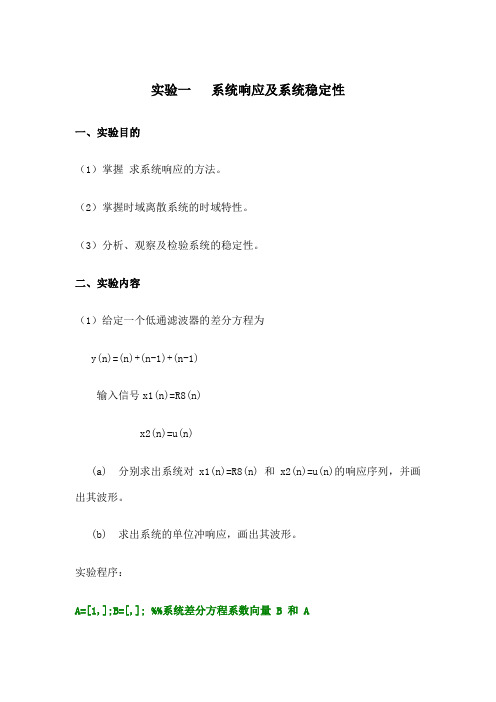
实验一系统响应及系统稳定性一、实验目的(1)掌握求系统响应的方法。
(2)掌握时域离散系统的时域特性。
(3)分析、观察及检验系统的稳定性。
二、实验内容(1)给定一个低通滤波器的差分方程为y(n)=(n)+(n-1)+(n-1)输入信号x1(n)=R8(n)x2(n)=u(n)(a) 分别求出系统对x1(n)=R8(n) 和x2(n)=u(n)的响应序列,并画出其波形。
(b) 求出系统的单位冲响应,画出其波形。
实验程序:A=[1,];B=[,]; %%系统差分方程系数向量 B 和 Ax1n=[1 1 1 1 1 1 1 1 zeros(1,50)]; %产生信号 x1(n)=R8(n) x2n=ones(1,128); %产生信号 x2(n)=u(n)y1n=filter(B,A,x1n); %求系统对 x1(n)的响应 y1(n)n=0:length(y1n)-1;subplot(2,2,1);stem(n,y1n,'.');title('(a) 系统对 R_8(n)的响应y_1(n)');xlabel('n');ylabel('y_1(n)');y2n=filter(B,A,x2n); %求系统对 x2(n)的响应 y2(n)n=0:length(y2n)-1;subplot(2,2,2);stem(n,y2n,'.');title('(b) 系统对 u(n)的响应y_2(n)');xlabel('n');ylabel('y_2(n)');hn=impz(B,A,58); %求系统单位脉冲响应 h(n) n=0:length(hn)-1;subplot(2,2,3);y=hn;stem(n,hn,'.');title('(c) 系统单位脉冲响应h(n)');xlabel('n');ylabel('h(n)');运行结果图:(2)给定系统的单位脉冲响应为h1(n)=R10(n)h2(n)= δ(n)+δ(n-1)+δ(n-2)+δ(n-3)用线性卷积法分别求系统h1(n)和h2(n)对x1(n)=R8(n)的输出响应,并画出波形。
数字信号处理实验一(上机)报告

数字信号处理实验报告实验名称:实验一离散时间信号的时域表示实验时间: 2014 年 9 月 16 日学号:201211106134 姓名:孙舸成绩:评语:一、实验目的1、熟悉MATLAB命令,掌握离散时间信号-序列的时域表示方法;2、掌握用MATLAB描绘二维图像的方法;3、掌握用MATLAB对序列进行基本的运算和时域变换的方法。
二、实验原理与计算方法(一)序列的表示方法序列的表示方法有列举法、解析法和图形法,相应的用MATLAB也可以有这样几种表示方法,分别介绍如下:1、列举法在MATLAB中,用一个列向量来表示一个有限长序列,由于一个列向量并不包含位置信息,因此需要用表示位置的n和表示量值的x两个向量来表示任意一个序列,如:例1.1:>>n=[-3,-2,-1,0,1,2,3,4];>>x=[2,1,-1,0,1,4,3,7];如果不对向量的位置进行定义,则MATLAB 默认该序列的起始位置为n=0。
由于内存有限,MATLAB 不能表示一个无限序列。
2、解析法对于有解析表达式的确定信号,首先定义序列的范围即n 的值,然后直接写出该序列的表达式,如:例1.2:实现实指数序列n n x )9.0()(=,100≤≤n 的MATLAB 程序为: >>n=[0:10];>>x=(0.9).^n;例1.3:实现正余弦序列)5.0sin(2)31.0cos(3)(n n n x πππ++=,155≤≤n 的MATLAB 程序为:>>n=[5:15];>>x=3*cos(0.1*pi*n+pi/3)+2*sin(0.5*pi*n);3、图形法在MATLAB 中用图形法表示一个序列,是在前两种表示方法的基础上将序列的各个量值描绘出来,即首先对序列进行定义,然后用相应的画图语句画图,如:例1.4:绘制在1中用列举法表示的序列的图形,则在向量定义之后加如下相应的绘图语句:>>stem(n,x);此时得到的图形的横坐标范围由向量n的值决定,为-3到4,纵坐标的范围由向量x的值决定,为-1到7。
数字信号处理上机实验 作业结果与说明 实验三、四、五
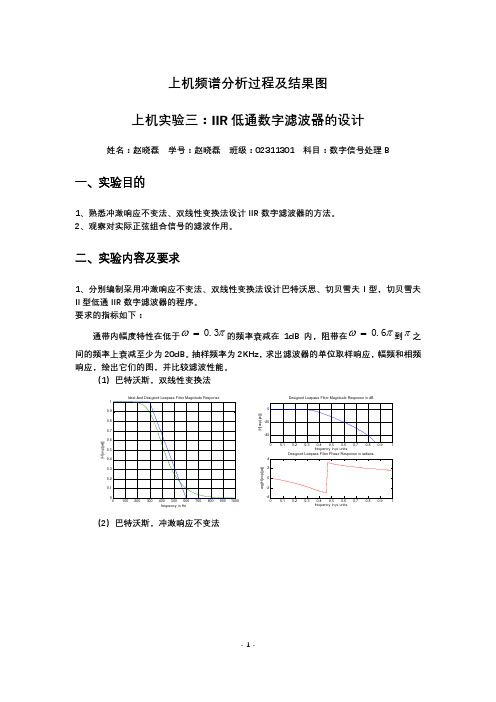
上机频谱分析过程及结果图 上机实验三:IIR 低通数字滤波器的设计姓名:赵晓磊 学号:赵晓磊 班级:02311301 科目:数字信号处理B一、实验目的1、熟悉冲激响应不变法、双线性变换法设计IIR 数字滤波器的方法。
2、观察对实际正弦组合信号的滤波作用。
二、实验内容及要求1、分别编制采用冲激响应不变法、双线性变换法设计巴特沃思、切贝雪夫I 型,切贝雪夫II 型低通IIR 数字滤波器的程序。
要求的指标如下:通带内幅度特性在低于πω3.0=的频率衰减在1dB 内,阻带在πω6.0=到π之间的频率上衰减至少为20dB 。
抽样频率为2KHz ,求出滤波器的单位取样响应,幅频和相频响应,绘出它们的图,并比较滤波性能。
(1)巴特沃斯,双线性变换法Ideal And Designed Lowpass Filter Magnitude Responsefrequency in Hz|H [e x p (j w )]|frequency in pi units|H [ex p (j w )]|Designed Lowpass Filter Phase Response in radians frequency in pi unitsa r g (H [e x p (j w )](2)巴特沃斯,冲激响应不变法(3)切贝雪夫I 型,双线性变换法(4)切贝雪夫Ⅱ型,双线性变换法综合以上实验结果,可以看出,使用不同的模拟滤波器数字化方法时,滤波器的性能可能产生如下差异:使用冲击响应不变法时,使得数字滤波器的冲激响应完全模仿模拟滤波器的冲激响应,也就是时域逼急良好,而且模拟频率和数字频率之间呈线性关系;但频率响应有混叠效应。
frequency in Hz|H [e x p (j w )]|Designed Lowpass Filter Magnitude Response in dBfrequency in pi units|H [e x p (j w )]|frequency in pi unitsa r g (H [e x p (j w )]Ideal And Designed Lowpass Filter Magnitude Responsefrequency in Hz|H [e x p (j w )]|frequency in pi units|H [e xp (j w )]|frequency in pi unitsa r g (H [e x p (j w )]Ideal And Designed Lowpass Filter Magnitude Responsefrequency in Hz|H [e x p (j w )]|frequency in pi units|H [ex p (j w )]|Designed Lowpass Filter Phase Response in radiansfrequency in pi unitsa r g (H [e x p (j w )]使用双线性变换法时,克服了多值映射的关系,避免了频率响应的混叠现象;在零频率附近,频率关系接近于线性关系,高频处有较大的非线性失真。
数字信号处理上机实验
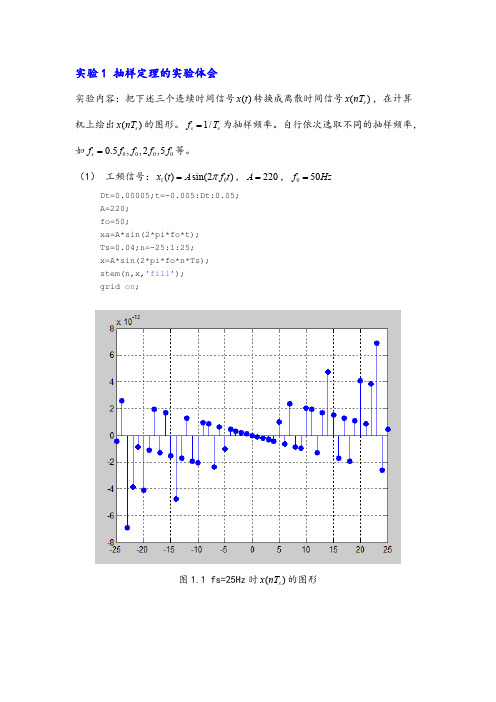
对全部高中资料试卷电气设备,在安装过程中以及安装结束后进行高中资料试卷调整试验;通电检查所有设备高中资料电试力卷保相护互装作置用调与试相技互术关,系电,力通根保1据过护生管高产线中工敷资艺设料高技试中术卷资0配不料置仅试技可卷术以要是解求指决,机吊对组顶电在层气进配设行置备继不进电规行保范空护高载高中与中资带资料负料试荷试卷下卷问高总题中体2资2配,料置而试时且卷,可调需保控要障试在各验最类;大管对限路设度习备内题进来到行确位调保。整机在使组管其高路在中敷正资设常料过工试程况卷中下安,与全要过,加度并强工且看作尽护下可关都能于可地管以缩路正小高常故中工障资作高料;中试对资卷于料连继试接电卷管保破口护坏处进范理行围高整,中核或资对者料定对试值某卷,些弯审异扁核常度与高固校中定对资盒图料位纸试置,卷.编保工写护况复层进杂防行设腐自备跨动与接处装地理置线,高弯尤中曲其资半要料径避试标免卷高错调等误试,高方要中案求资,技料编术试写5交、卷重底电保要。气护设管设装备线备置4高敷、调动中设电试作资技气高,料术课中并3试、中件资且卷管包中料拒试路含调试绝验敷线试卷动方设槽技作案技、术,以术管来及架避系等免统多不启项必动方要方式高案,中;为资对解料整决试套高卷启中突动语然过文停程电机中气。高课因中件此资中,料管电试壁力卷薄高电、中气接资设口料备不试进严卷行等保调问护试题装工,置作合调并理试且利技进用术行管,过线要关敷求运设电行技力高术保中。护资线装料缆置试敷做卷设到技原准术则确指:灵导在活。分。对线对于盒于调处差试,动过当保程不护中同装高电置中压高资回中料路资试交料卷叉试技时卷术,调问应试题采技,用术作金是为属指调隔发试板电人进机员行一,隔变需开压要处器在理组事;在前同发掌一生握线内图槽部纸内 故资,障料强时、电,设回需备路要制须进造同行厂时外家切部出断电具习源高题高中电中资源资料,料试线试卷缆卷试敷切验设除报完从告毕而与,采相要用关进高技行中术检资资查料料和试,检卷并测主且处要了理保解。护现装场置设。备高中资料试卷布置情况与有关高中资料试卷电气系统接线等情况,然后根据规范与规程规定,制定设备调试高中资料试卷方案。
数字信号处理实验报告完整版[5篇模版]
![数字信号处理实验报告完整版[5篇模版]](https://img.taocdn.com/s3/m/7b21a71bb5daa58da0116c175f0e7cd184251866.png)
数字信号处理实验报告完整版[5篇模版]第一篇:数字信号处理实验报告完整版实验 1利用 T DFT 分析信号频谱一、实验目的1.加深对 DFT 原理的理解。
2.应用 DFT 分析信号的频谱。
3.深刻理解利用DFT 分析信号频谱的原理,分析实现过程中出现的现象及解决方法。
二、实验设备与环境计算机、MATLAB 软件环境三、实验基础理论T 1.DFT 与与 T DTFT 的关系有限长序列的离散时间傅里叶变换在频率区间的N 个等间隔分布的点上的 N 个取样值可以由下式表示:212 /0()|()()0 1Nj knjNk NkX e x n e X k k Nπωωπ--====≤≤-∑由上式可知,序列的 N 点 DFT ,实际上就是序列的 DTFT 在 N 个等间隔频率点上样本。
2.利用 T DFT 求求 DTFT方法 1 1:由恢复出的方法如下:由图 2.1 所示流程可知:101()()()Nj j n kn j nNn n kX e x n e X k W eNωωω∞∞----=-∞=-∞=⎡⎤==⎢⎥⎣⎦∑∑∑由上式可以得到:IDFT DTFT第二篇:数字信号处理实验报告JIANGSUUNIVERSITY OF TECHNOLOGY数字信号处理实验报告学院名称:电气信息工程学院专业:班级:姓名:学号:指导老师:张维玺(教授)2013年12月20日实验一离散时间信号的产生一、实验目的数字信号处理系统中的信号都是以离散时间形态存在的,所以对离散时间信号的研究是数字信号的基本所在。
而要研究离散时间信号,首先需要产生出各种离散时间信号。
使用MATLAB软件可以很方便地产生各种常见的离散时间信号,而且它还具有强大绘图功能,便于用户直观地处理输出结果。
通过本实验,学生将学习如何用MATLAB产生一些常见的离散时间信号,实现信号的卷积运算,并通过MATLAB中的绘图工具对产生的信号进行观察,加深对常用离散信号和信号卷积和运算的理解。
DSP实验报告2-数字信号处理
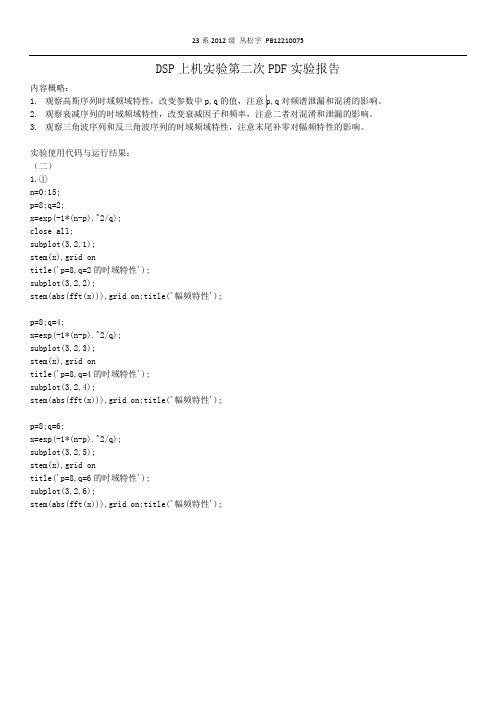
23 系 2012 级 丛松宇 PB12210075
3. clear; n=1:8; for i=1:4 x(i)=i; end for i=5:8 x(i)=9-i; end close all; subplot(2,4,1); stem(x);grid on; title('8 点三角波序列'); subplot(2,4,2); stem(abs(fft(x,8)));grid on; n=1:16; for i=9:16 x(i)=0; end subplot(2,4,3); stem(x);grid on; title('16 点三角波序列'); subplot(2,4,4); stem(abs(fft(x,16)));grid on; n=1:8; for i=1:4 x(i)=5-i; end
23 系 2012 级 丛松宇 PB12210075
1.② n=0:15; q=8;p=8; x=exp(-1*(n-p).^2/q); close all; subplot(3,2,1); stem(x),grid on title('q=8,p=8 的时域特性'); subplot(3,2,2); stem(abs(fft(x))),grid on;title('频域特性'); q=8;p=13; x=exp(-1*(n-p).^2/q); subplot(3,2,3); stem(x),grid on title('q=8,p=13 的时域特性'); subplot(3,2,4); stem(abs(fft(x))),grid on;title('频域特性'); q=8;p=14; x=exp(-1*(n-p).^2/q); subplot(3,2,5); stem(x),grid on title('q=8,p=14 的时域特性'); subplot(3,2,6); stem(abs(fft(x))),grid on;title('频域特性');
数字信号处理实验报告11-12-10
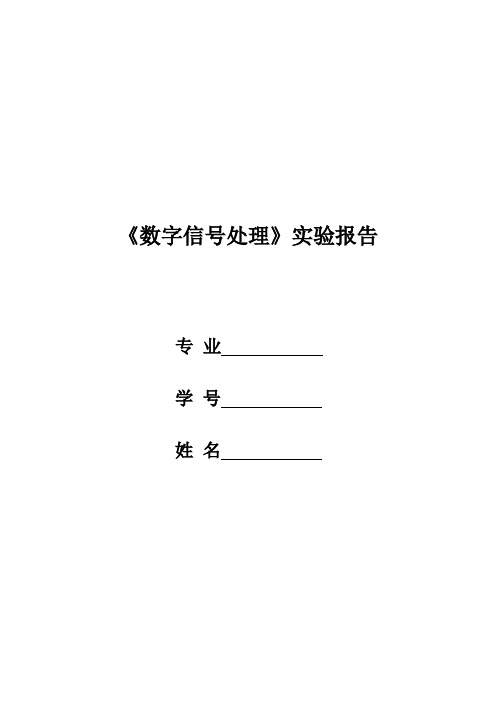
《数字信号处理》实验报告专业学号姓名实验一 利用FFT 实现快速卷积一、实验目的1.加深理解FFT 在实现数字滤波(或快速卷积)中的重要作用,更好的利用FFT 进行数字信号处理。
2.掌握循环卷积和线性卷积两者之间的关系。
二、实验原理用FFT 来快速计算有限长度序列的线性卷积。
这种方法就是先将输入信号x(n)通过FFT 变换为它的频谱采样值()x k ,然后再和FIR 滤波器的频响采样值H(k)相乘,H(k)可事先存放在存储器中,最后再将乘积H(k)X(k)通过快速傅里叶变换(简称IFFT )还原为时域序列,即得到输出y(n)。
现以FFT 求有限长序列的卷积及求有限长度序列与较长序列间的卷积为例来讨论FFT 的快速卷积方法。
序列x(n)和h(n)的长差不多。
设x(n)的长为N 1,h(n)的长为N 2,要求∑-=-=⊗=1)()()()()(N m m n x m h n y n x n y用FFT 完成这一卷积的具体步骤如下:①为使两有限长序列的线性卷积可用其循环卷积代替而不发生混叠,必须选择循环卷积长度121-+≥N N N ,若采用基2-FFT 完成卷积运算,要求m N 2=(m 为整数)。
②用补零方法使x(n)和h(n)变成列长为N 的序列。
1122()01()01()01()01x n n N x n N n N h n n N h n N n N ≤≤-⎧=⎨≤≤-⎩≤≤-⎧=⎨≤≤-⎩③用FFT 计算x(n)和h(n)的N 点离散傅里叶变换。
④完成X(k)和H(k)乘积,)()()(k H k x k Y = ⑤用FFT 计算 ()Y k 的离散傅里叶反变换得*10*10)(1)(1)(⎭⎬⎫⎩⎨⎧⎥⎦⎤⎢⎣⎡=⎥⎦⎤⎢⎣⎡=∑∑-=--=N k nk N nk N N k W k Y N W k Y N n y三、主要实验仪器及材料微型计算机、Matlab6.5教学版。
四、实验内容1.数字滤波器的脉冲响应为()22()1/2(),8nN h n R n N ==。
数字信号处理上机实验
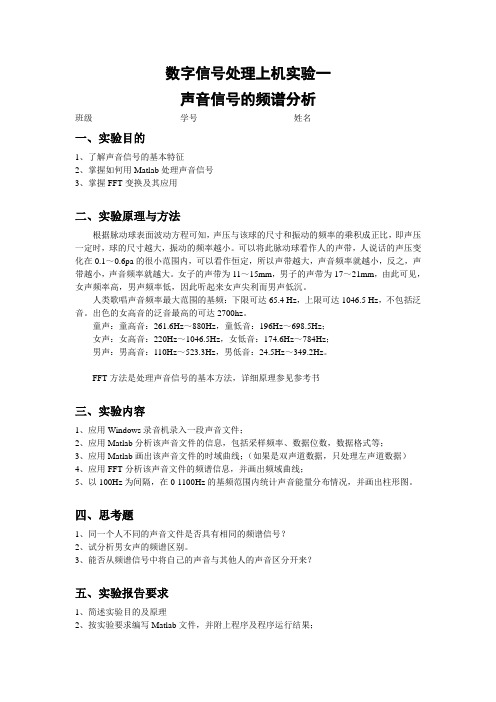
数字信号处理上机实验一声音信号的频谱分析班级___________________ 学号_____________________ 姓名____________________一、实验目的1、了解声音信号的基本特征2、掌握如何用Matlab处理声音信号3、掌握FFT变换及其应用二、实验原理与方法根据脉动球表面波动方程可知,声压与该球的尺寸和振动的频率的乘积成正比,即声压一定时,球的尺寸越大,振动的频率越小。
可以将此脉动球看作人的声带,人说话的声压变化在0.1~0.6pa的很小范围内,可以看作恒定,所以声带越大,声音频率就越小,反之,声带越小,声音频率就越大。
女子的声带为11~15mm,男子的声带为17~21mm,由此可见,女声频率高,男声频率低,因此听起来女声尖利而男声低沉。
人类歌唱声音频率最大范围的基频:下限可达65.4 Hz,上限可达1046.5 Hz,不包括泛音。
出色的女高音的泛音最高的可达2700hz。
童声:童高音:261.6Hz~880Hz,童低音:196Hz~698.5Hz;女声:女高音:220Hz~1046.5Hz,女低音:174.6Hz~784Hz;男声:男高音:110Hz~523.3Hz,男低音:24.5Hz~349.2Hz。
FFT方法是处理声音信号的基本方法,详细原理参见参考书三、实验内容1、应用Windows录音机录入一段声音文件;2、应用Matlab分析该声音文件的信息,包括采样频率、数据位数,数据格式等;3、应用Matlab画出该声音文件的时域曲线;(如果是双声道数据,只处理左声道数据)4、应用FFT分析该声音文件的频谱信息,并画出频域曲线;5、以100Hz为间隔,在0-1100Hz的基频范围内统计声音能量分布情况,并画出柱形图。
四、思考题1、同一个人不同的声音文件是否具有相同的频谱信号?2、试分析男女声的频谱区别。
3、能否从频谱信号中将自己的声音与其他人的声音区分开来?五、实验报告要求1、简述实验目的及原理2、按实验要求编写Matlab文件,并附上程序及程序运行结果;3、结合所学知识总结实验中的主要结论;4、简要回答思考题。
数字信号处理上机报告-一

数字信号处理上机报告-一数字信号处理第一次上机实验报告实验一:设给定模拟信号()1000t a x t e -=,的单位是ms 。
(1) 利用MATLAB 绘制出其时域波形和频谱图(傅里叶变换),估计其等效带宽(忽略谱分量降低到峰值的3%以下的频谱)。
(2) 用两个不同的采样频率对给定的进行采样。
○1。
○2。
比较两种采样率下的信号频谱,并解释。
实验一MATLAB 程序:(1)N=10; Fs=5; Ts=1/Fs;n=[-N:Ts:N];xn=exp(-abs(n)); w=-4*pi:0.01:4*pi; X=xn*exp(-j*(n'*w)); subplot(211) plot(n,xn);title('x_a(t)时域波形');xlabel('t/ms');ylabel('x_a(t)');t ()a x t ()()15000s a f x t x n =以样本秒采样得到。
()()11j x n X e ω画出及其频谱()()11000s a f x t x n =以样本秒采样得到。
()()11j x n X e ω画出及其频谱axis([-10, 10, 0, 1]);subplot(212);plot(w/pi,abs(X));title('x_a(t)频谱图');xlabel('\omega/\pi');ylabel('X_a(e ^(j\omega))');ind = find(X >=0.03*max(X))*0.01; eband = (max(ind) -min(ind));fprintf('等效带宽为 %fKHZ\n',eband); 运行结果:等效带宽为 12.110000KHZ(2).N=10;omega=-3*pi:0.01:3*pi;%Fs=5000Fs=5;Ts=1/Fs;n=-N:Ts:N;xn=exp(-abs(n));X=xn*exp(-j*(n'*omega));subplot(221);stem(n,xn);grid on;axis([-10, 10, 0, 1.25]);title('时域波形(f_s=5000)');xlabel('n');ylabel('x_1(n)');subplot(222);plot(omega/pi,abs(X));title('频谱图(f_s=5000)');xlabel('\omega/\pi');ylabel('X_1(f)');%Fs=1000Fs=1;Ts=1/Fs;n=-N:Ts:N;xn=exp(-abs(n));X=xn*exp(-j*(n'*omega));subplot(223);stem(n,xn);grid on;axis([-10, 10, 0, 1.25]);title('时域波形(f_s=1000)');xlabel('n');ylabel('x_2(n)');subplot(224);plot(omega/pi,abs(X));title('频谱图(f_s=1000)');xlabel('\omega/\pi');ylabel('X_2(f)');运行结果:实验二:给定一指数型衰减信号,采样率,为采样周期。
数字信号处理实验报告_完整版

实验1 利用DFT 分析信号频谱一、实验目的1.加深对DFT 原理的理解。
2.应用DFT 分析信号的频谱。
3.深刻理解利用DFT 分析信号频谱的原理,分析实现过程中出现的现象及解决方法。
二、实验设备与环境 计算机、MATLAB 软件环境 三、实验基础理论1.DFT 与DTFT 的关系有限长序列x (n )(0≤n ≤N −1)的离散时间傅里叶变换X (e jω)在频率区间(0≤ω≤2π)的N 个等间隔分布的点kω=2πk /N (0≤k ≤N −1)上的N 个取样值可以由下式表示:212/0()|()()01N jkn j Nk N k X e x n eX k k N πωωπ--====≤≤-∑由上式可知,序列x (n )的N 点DFT X k ,实际上就是x (n )序列的DTFT 在N 个等间隔频率点kω=2πk /N (0≤k ≤N −1)上样本X k 。
2.利用DFT 求DTFT方法1:由恢复出的方法如下:由图2.1所示流程可知:101()()()N j j nkn j nN n n k X e x n eX k W e N ωωω∞∞----=-∞=-∞=⎡⎤==⎢⎥⎣⎦∑∑∑ 由上式可以得到:IDFTDTFTX (ejω)12()()()Nj k kX e X k Nωπφω==-∑ 其中为内插函数12sin(/2)()sin(/2)N j N x eN ωωφω--= 方法2:实际在MATLAB 计算中,上述插值运算不见得是最好的办法。
由于DFT 是DTFT 的取样值,其相邻两个频率样本点的间距为2π/N ,所以如果我们增加数据的长度N ,使得到的DFT 谱线就更加精细,其包络就越接近DTFT 的结果,这样就可以利用DFT 计算DTFT 。
如果没有更多的数据,可以通过补零来增加数据长度。
3.利用DFT 分析连续信号的频谱采用计算机分析连续时间信号的频谱,第一步就是把连续信号离散化,这里需要进行两个操作:一是采样,二是截断。
数字信号处理上机实验报告
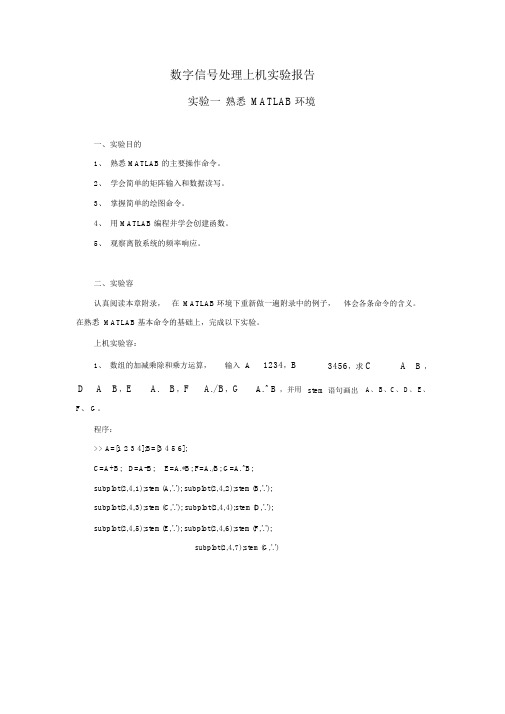
数字信号处理上机实验报告实验一熟悉MATLAB环境一、实验目的1、熟悉 MATLAB的主要操作命令。
2、学会简单的矩阵输入和数据读写。
3、掌握简单的绘图命令。
4、用 MATLAB编程并学会创建函数。
5、观察离散系统的频率响应。
二、实验容认真阅读本章附录,在MATLAB环境下重新做一遍附录中的例子,体会各条命令的含义。
在熟悉 MATLAB基本命令的基础上,完成以下实验。
上机实验容:1、数组的加减乘除和乘方运算,输入A1234,B3456,求C A B ,D A B,E A. B,F A./ B,G A.^ B ,并用stem语句画出A、 B、C、 D、 E、F、 G。
程序:>> A=[1 2 3 4];B=[3 4 5 6];C=A+B; D=A-B; E=A.*B; F=A./B; G=A.^B;subplot(2,4,1);stem(A,'.'); subplot(2,4,2);stem(B,'.');subplot(2,4,3);stem(C,'.'); subplot(2,4,4);stem(D,'.');subplot(2,4,5);stem(E,'.'); subplot(2,4,6);stem(F,'.');subplot(2,4,7);stem(G,'.')2、用MATLAB实现下列序列。
a)x(n)0.8n0n15b) x(n)e(0. 2 3 j ) n0n 15c)x(n)3cos(0.125 n0.2 ) 2sin(0.25 n 0.1 ) 0 n 15程序:A)clear;clc;n=[0:15];x1=0.8.^n;subplot(3,1,1),stem(x1)title('x1=0.8^n')xlabel('n'); ylabel('x1');B)clear;clc;n=[0:15];x2=exp((0.2+3j)*n);subplot(3,1,1),stem(x2)title('x2=exp((0.2+3j)*n)')xlabel('n'); ylabel('x2');C)clear;clc;n=[0:15];x3=3*cos(0.125*pi*n+0.2*pi)+2*sin(0.25*pi*n+0.1*pi); subplot(3,1,1),stem(x3)title('x3=3*cos(0.125*pi*n+0.2*pi)+2*sin(0.25*pi*n+0.1*pi)') xlabel('n'); ylabel('x3');3、绘出下列时间常数的图形,对x 轴,y轴以及图形上方均须加上适当的标注:a)x(t )sin( 2 t )0t10sb)x(t )cos(100t )sin(t )0 t 4s>>m=0:0.01:10;n=0:0.01:4;x1t=sin(2*pi*m);x2t=cos(100*pi*n).*sin(pi*n);subplot(2,1,1);plot(m,x1t);subplot(2,1,2);plot(n,x2t);4、给定一因果系统 H(z)=(1+ 2z- 1z-2)/( 1- 0.67z 1z 2),求出并绘制H(z)的幅频响应与相频响应。
数字信号处理实验MATLAB上机DOC
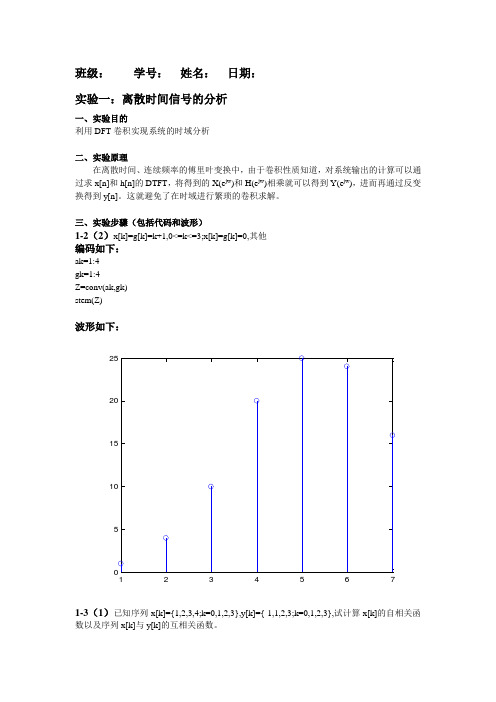
班级: 学号: 姓名: 日期: 实验一:离散时间信号的分析一、实验目的利用DFT 卷积实现系统的时域分析二、实验原理在离散时间、连续频率的傅里叶变换中,由于卷积性质知道,对系统输出的计算可以通过求x[n]和h[n]的DTFT ,将得到的X(e jw )和H(e jw )相乘就可以得到Y(e jw ),进而再通过反变换得到y[n]。
这就避免了在时域进行繁琐的卷积求解。
三、实验步骤(包括代码和波形)1-2(2)x[k]=g[k]=k+1,0<=k<=3;x[k]=g[k]=0,其他 编码如下:ak=1:4 gk=1:4Z=conv(ak,gk) stem(Z)波形如下:12345675101520251-3(1)已知序列x[k]={1,2,3,4;k=0,1,2,3},y[k]={-1,1,2,3;k=0,1,2,3},试计算x[k]的自相关函数以及序列x[k]与y[k]的互相关函数。
编码如下:x=[1,2,3,4];kx=0:3; y=[-1,1,-2,3];ky=0:3; xf=fliplr(x); s1=conv(x,xf); s2=conv(xf,y); yf=fliplr(y); s3=conv(yf,x);k1=kx(1)+ky(1):kx(end)+ky(end); kxf=-fliplr(kx);k2=kxf(1)+ky(1):kxf(end)+ky(end); kyf=-fliplr(ky);k3=kyf(1)+kx(1):kyf(end)+kx(end); subplot(2,2,1); stem(k1,s1);xlabel('k1');ylabel('s1'); subplot(2,2,2); stem(k2,s2);xlabel('k2');ylabel('s2'); subplot(2,2,3) stem(k3,s3);xlabel('k3');ylabel('s3');波形如下:0246102030k1s 1-4-2024-10-50510k2s 2-4-2024-10-50510k3s 3M-1已知g1[t]=cos(6*pi*t),g2=cos(14*pi*t),g3=cos(26*pi*t),以抽样频率f(max)=10HZ对上述三个信号进行抽样。
西电数字信号处理上机实验报告
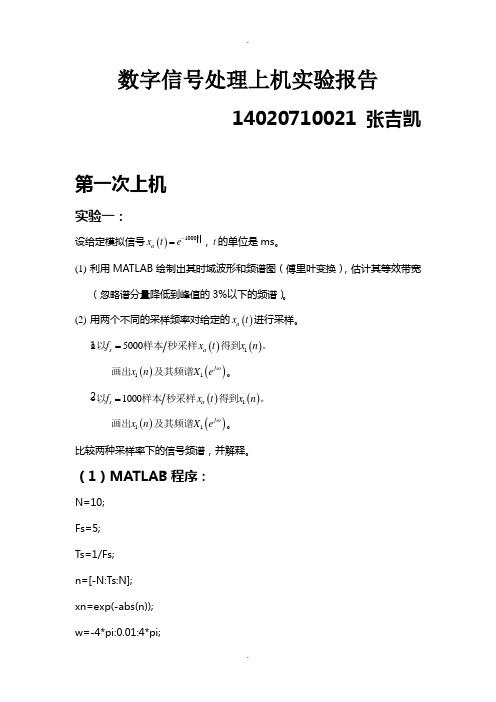
数字信号处理上机实验报告14020710021 张吉凯第一次上机实验一:设给定模拟信号()1000t a x t e -=,t 的单位是ms 。
(1) 利用MATLAB 绘制出其时域波形和频谱图(傅里叶变换),估计其等效带宽(忽略谱分量降低到峰值的3%以下的频谱)。
(2) 用两个不同的采样频率对给定的()a x t 进行采样。
○1()()15000s a f x t x n =以样本秒采样得到。
()()11j x n X e ω画出及其频谱。
○2()()11000s a f x t x n =以样本秒采样得到。
()()11j x n X e ω画出及其频谱。
比较两种采样率下的信号频谱,并解释。
(1)MATLAB 程序:N=10; Fs=5; Ts=1/Fs;n=[-N:Ts:N];xn=exp(-abs(n)); w=-4*pi:0.01:4*pi;X=xn*exp(-j*(n'*w));subplot(211)plot(n,xn);title('x_a(t)时域波形');xlabel('t/ms');ylabel('x_a(t)');axis([-10, 10, 0, 1]);subplot(212);plot(w/pi,abs(X));title('x_a(t)频谱图');xlabel('\omega/\pi');ylabel('X_a(e^(j\omega))'); ind = find(X >=0.03*max(X))*0.01;eband = (max(ind) -min(ind));fprintf('等效带宽为%fKHZ\n',eband);运行结果:等效带宽为12.110000KHZ(2)MATLAB程序:N=10;omega=-3*pi:0.01:3*pi;%Fs=5000Fs=5;Ts=1/Fs;n=-N:Ts:N;xn=exp(-abs(n));X=xn*exp(-j*(n'*omega));subplot(2,2,1);stem(n,xn);grid on;axis([-10, 10, 0, 1.25]); title('时域波形(f_s=5000)');xlabel('n');ylabel('x_1(n)');subplot(2,2,2);plot(omega/pi,abs(X));title('频谱图(f_s=5000)');xlabel('\omega/\pi');ylabel('X_1(f)');grid on;%Fs=1000Fs=1;Ts=1/Fs;n=-N:Ts:N;xn=exp(-abs(n));X=xn*exp(-j*(n'*omega));subplot(2,2,3);stem(n,xn);grid on;axis([-10, 10, 0, 1.25]); title('时域波形(f_s=1000)');xlabel('n');ylabel('x_2(n)');grid on; subplot(2,2,4); plot(omega/pi,abs(X)); title('频谱图(f_s=1000)'); xlabel('\omega/\pi'); ylabel('X_2(f)'); grid on;运行结果:实验二:给定一指数型衰减信号()()0cos 2at x t e f t π-=,采样率1s f T=,T 为采样周期。
数字信号处理上机实习报告

数字信号处理上机实习报告————————————————————————————————作者:————————————————————————————————日期:2专题一 离散卷积的计算一、实验内容设线性时不变(LTI )系统的冲激响应为h(n),输入序列为x (n) 1、h (n)=(0.8)n,0≤n ≤4; x (n)=u (n)—u (n-4) 2、h (n)=(0.8)n u (n), x (n )=u(n)—u (n-4) 3、h(n)=(0。
8)nu (n ), x(n)=u (n) 求以上三种情况下系统的输出y (n )。
二、实验目的1、掌握离散卷积计算机实现.2、进一步对离散信号卷积算法的理解.三、原理及算法概要算法:把冲激响应h(n)与输入序列x (n)分别输入到程序中,然后调用离散卷积函数y=conv (x 。
,h)即可得到所要求的结果.原理:离散卷积定义为 ∑∞-∞=-=k k n h k x n y )()()(当序列为有限长时,则∑=-=nk k n h k x n y 0)()()(四.理论计算1、h (n)=(0。
8)n,0≤n≤4; x(n )=u (n )—u(n —4) ∑∞-∞=-=*=m m n h m x n h n x n y )()()()()((a) 当n 〈0 时,y (n )=0 (b ) 当30≤≤n 时,∑==nm n y 0)((0。
8)n(c ) 当74≤≤n 时,∑-==43)(n m n y (0.8)n(d ) 当n 〉7时,y (n )=0理论结果与上图实验结果图中所示吻合。
2、h(n)=(0.8)nu(n ), x(n )=u(n)—u(n-4) ∑∞-∞=-=*=m m n h m x n h n x n y )()()()()((a) 当n <0 时,y (n )=0 (b) 当30≤≤n 时,∑==nm n y 0)((0。
数字信号处理上机实验汇总(原创)

信 号 y=u(t+3)-2u(t) 1.5
1
0.5
0
y
-0.5
-1
-1.5 -5
-4
-3
-2
-1
0 t
1
2
3
4
5
(2)绘出复指数信号 x(t ) e0.2t cos(2t 0.5) 的波形。
2
运行结果:
连 续 复 指 数 信 号 x[t]=cos(2*t+0.5).*exp(0.2*t) 2000 1500 1000 500 0
验证结合律
y1(n)=(x1[n]*x2[n])*x3[n]
6000 4000 2000 0 -2000 -100
-80
-60
-40
-20
0 n
20
40
60
80
100
y2(n)=x1[n]*(x2[n]*x3[n])
10000
5000
0
-5000 -100
-80
-60
-40
-20
0 n
20
40
60
80
5
1
x(n)
0.5
0 -2
-1.5
-1
-0.5
0 n
0.5
1
1.5
2
1
h(n)
0.5
0 -2
-1.5
-1
-0.5
0 n
0.5
1
1.5
2
6
y ( n) =x(n)*h(n)
4
2
0 -4
-3
-2
-1
0 n
1
2
3
4
(2) 对下面三个序列, 用 conv_m()函数来验证卷积特性 (交换律、 结合律、 分配律) 交换律 结合律 分配律 其
- 1、下载文档前请自行甄别文档内容的完整性,平台不提供额外的编辑、内容补充、找答案等附加服务。
- 2、"仅部分预览"的文档,不可在线预览部分如存在完整性等问题,可反馈申请退款(可完整预览的文档不适用该条件!)。
- 3、如文档侵犯您的权益,请联系客服反馈,我们会尽快为您处理(人工客服工作时间:9:00-18:30)。
数字信号处理上机实验报告2018年5月21日M 2.21.题目The square wave and the sawtooth wave are two periodic sequences as sketched in figure ing the function stem. The input data specified by the user are: desired length L of the sequence, peak value A, and the period N. For the square wave sequence an additional user-specified parameter is the duty cycle, which is the percent of the period for which the signal is positive. Using this program generate the first 100 samples of each of the above sequences with a sampling rate of 20 kHz ,a peak value of 7, a period of 13 ,and a duty cycle of 60% for the square wave.2.程序clc ;close all;f = 20000;%采样频率L = 100*(1/f);%采样个数A = 7;%最大值N = 13;%周期t = 0:1/20000:L-1/20000;%t=0:1:20;y1 =(A * sawtooth(2*pi/N*f*t));m =(A - max(y1))/2;y2 = m+y1;figure(1);subplot(2,1,1);stem (t,y2);y3 = square(2*pi/13*20000*t,60);subplot(2,1,2)stem (t,y3);3.结果M 2.41.题目(a)Write a matlab program to generate a sinusoidal sequence x[n]= Acos(ω0 n+Ф) and plotthe sequence using the stem function. The input data specified by the user are the desired length L, amplitude A, the angular frequency ω0 , and the phase Фwhere 0<ω0 <pi and 0<=Ф<=2pi. Using this program generate the sinusoidal sequences shown in figure 2.15.(b)Generate sinusoidal sequences with the angular frequencies given in Problem 2.22.Determine the period of each sequence from the plot and verify the result theoretically.2.程序clc;clear all;close all;L = input('Desired length = ');A = input('Amplitude = ');omega = input('Angular frequency = '); phi = input('Phase = ');%信号产生n = 0:L-1;x = A*cos(omega*n + phi);stem(n,x);xlabel('n');ylabel('幅度');title(['\omega_{o} = ',num2str(omega)]);3.结果(a)ω0=0ω0=0.1πω0=0.8πω0=1.2π(b)ω0=0.14πω0=0.24πω0=0.34πω0=0.68πω0=0.75πM 2.51.题目Generate the sequences of problem 2.21(b) to 2.21(e) using matlab.2.程序(b)n = 0 : 99;x=sin(0.6*pi*n+0.6*pi);stem(n,x);xlabel('n');ylabel('幅度');(c)n = 0 : 99;x=2*cos(1.1*pi*n-0.5*pi)+2*sin(0.7*pi*n);stem(n,x);xlabel('n');ylabel('幅度');(d)n = 0 : 99;x=3*sin(1.3*pi*n-4*cos(0.3*pi*n+0.45*pi));stem(n,x);xlabel('n');ylabel('幅度');(e)n = 0 : 99;x=5*sin(1.2*pi*n+0.65*pi)+4*sin(0.8*pi*n)-cos(0.8*pi*n);stem(n,x);xlabel('n');ylabel('幅度');(f)n = 0 : 99;x=mod(n,6);stem(n,x);xlabel('n');ylabel('幅度');3.结果(b)(c)(d)(e)(f)M 2.61.题目Write a matlab program to plot a continuous-time sinusoidal signal and its sampled version and verify figure 2.19. You need to use the hold function to keep both plots.2.程序clc; close all; clear all;fre_sin = input('Frequency of sinusoid in Hz = ');fre_sample = input('Samplig frequency in Hz = ');t = 0:0.001:1;g = cos(2*pi*fre_sin*t);plot(t,g,'-')xlabel('时间t');ylabel('幅度')holdn = 0:1:fre_sample;g_samle = cos(2*pi*fre_sin*n/fre_sample);plot(n/fre_sample,g_sample,'x');hold off3.结果频率10Hz;采样频率500Hz.M 3.11.题目Using program 3_1 determine and plot the real and imaginary parts and the magnitude and phase spectra of the following DTFT for various values of r and θ:G(e jω)=1, 0<r<1.1−2r(cosθ)e−jω+r2e−2jω2.程序clc; close all; clear all;%采样频率k = 1000;r = input('r= ');theda = input('theda= ');%num 多项式分子系数%den 多项式分母系数num = [1,0,0];den = [1,-2*r*cos(theda),r^2];w=0:pi/k:pi;h=freqz(num,den,w);subplot(221)plot(w/pi,real(h));grid on;title('real part')xlabel('\omega/\pi');ylabel('Amplitude')subplot(222)plot(w/pi,imag(h));grid on;title('imaginary part')xlabel('\omega/\pi');ylabel('Amplitude')subplot(223)plot(w/pi,abs(h));grid on;title('magnitude spectrum')xlabel('\omega/\pi');ylabel('magnitude')subplot(224)plot(w/pi,angle(h));grid on;title('phase spectrum')xlabel('\omega/\pi');ylabel('phase,radians')3.结果(a)r=0.8 θ=π/6(b)r=0.6 θ=π/3M 3.41.题目Using matlab verify the following general properties of the DTFT as listed in Table 3.2:(a) Linearity, (b) time-shifting, (c) frequency-shifting, (d) differentiation-in-frequency, (e) convolution, (f) modulation, and (g) Parseval’s relation. Since all data in matlab have to be finite-length vectors, the sequences to be used to verify the properties are thus restricted to be of finite length.2.程序clc;clear all;close all;N = input('The length of the sequence = ');k = 0:N-1;%g为正弦信号g = 2*sin(2*pi*k/(N/2));%h为余弦信号h = 3*cos(2*pi*k/(N/2));[G,w] = freqz(g,1);[H,w] = freqz(h,1);% 线性性质alpha = 0.5;beta = 0.25;y = alpha*g+beta*h;[Y,w] = freqz(y,1);figure(1);subplot(211),plot(w/pi,abs(Y));xlabel('\omega/\pi');ylabel('|Y(e^j^\omega)|');title('线性叠加后的频率特性');grid;% 画出Y 的频率特性subplot(212),plot(w/pi,alpha*abs(G)+beta*abs(H));xlabel('\omega/\pi');ylabel('\alpha|G(e^j^\omega)|+\beta|H(e^j^\omega)|');title('线性叠加前的频率特性');grid;% 画出alpha*G+beta*H 的频率特性% 时移性质n0 = 10;%时移10个的单位y2 = [zeros([1,n0]) g];[Y2,w] = freqz(y2,1);G0 = exp(-j*w*n0).*G;figure(2);subplot(211),plot(w/pi,abs(G0));xlabel('\omega/\pi');ylabel('|G0(e^j^\omega)|');title('G0的频率特性');grid;% 画出G0的频率特性subplot(212),plot(w/pi,abs(Y2));xlabel('\omega/\pi');ylabel('|Y2(e^j^\omega)|');title('Y2的频率特性');grid;% 画出Y2 的频率特性% 频移特性w0 = pi/2; % 频移pi/2r=256; %the value of w0 in terms of number of samplesk = 0:N-1;y3 = g.*exp(j*w0*k);[Y3,w] = freqz(y3,1);% 对采样的512个点分别进行减少pi/2,从而生成G(exp(w-w0)) k = 0:511;w = -w0+pi*k/512;G1 = freqz(g,1,w);figure(3);subplot(211),plot(w/pi,abs(Y3));xlabel('\omega/\pi');ylabel('|Y3(e^j^\omega)|');title('Y3的频率特性');grid;% 画出Y3的频率特性subplot(212),plot(w/pi,abs(G1));xlabel('\omega/\pi');ylabel('|G1(e^j^\omega)|');title('G1的频率特性');grid;% 画出G1 的频率特性% 频域微分k = 0:N-1;y4 = k.*g;[Y4,w] = freqz(y4,1);%在频域进行微分y0 = ((-1).^k).*g;G2 = [G(2:512)' sum(y0)]';delG = (G2-G)*512/pi;figure(4);subplot(211),plot(w/pi,abs(Y4));xlabel('\omega/\pi');ylabel('|Y4(e^j^\omega)|');title('Y4的频率特性');grid;% 画出Y4的频率特性subplot(212),plot(w/pi,abs(delG));xlabel('\omega/\pi');ylabel('|delG(e^j^\omega)|'); title('delG的频率特性');grid;% 画出delG的频率特性% 相乘性质y5 = conv(g,h);%时域卷积[Y5,w] = freqz(y5,1);figure(5);subplot(211),plot(w/pi,abs(Y5));xlabel('\omega/\pi');ylabel('|Y5(e^j^\omega)|'); title('Y5的频率特性');grid;% 画出Y5的频率特性subplot(212),plot(w/pi,abs(G.*H));%频域乘积xlabel('\omega/\pi');ylabel('|G.*H(e^j^\omega)|'); title('G.*H的频率特性');grid;% 画出G.*H的频率特性% 帕斯瓦尔定理y6 = g.*h;%对于freqz函数,在0到2pi直接取样[Y6,w] = freqz(y6,1,512,'whole');[G0,w] = freqz(g,1,512,'whole');[H0,w] = freqz(h,1,512,'whole');H1 = [fliplr(H0(1:129)') fliplr(H0(130:512)')]';val = 1/(512)*sum(G0.*H1);val1 = sum(g.*conj(h));val2 = sum(G0.*conj(H0))/512;3.结果(a)(b)(c)(d)(e)M 3.81.题目Using matlab compute the N-point DFTs of the length-N sequences of Problem 3.12 for N=3, 5, 7, and 10. Compare your results with that obtained by evaluating the DTFTs computed in Problem 3.12 at ω= 2pik/N, k=0, 1,……N-1.2.程序(a)clc;clear all;close all;N = input('The value of N = ');k = -N:N;y1 = ones([1,2*N+1]);w = 0:2*pi/255:2*pi;Y1 = freqz(y1, 1, w);Y1dft = fft(y1);k = 0:1:2*N;plot(w/pi,abs(Y1),k*2/(2*N+1),abs(Y1dft),'x');grid on;xlabel('Normalized frequency');ylabel('Amplitude');(b)clc;clear all;close all;N = input('The value of N = ');k = -N:N;y1 = ones([1,2*N+1]);y2 = y1 - abs(k)/N;w = 0:2*pi/255:2*pi;Y2 = freqz(y2, 1, w);%对y1做傅里叶变换Y2dft = fft(y2);k = 0:1:2*N;plot(w/pi,abs(Y2),k*2/(2*N+1),abs(Y2dft),'x');grid on;xlabel('Normalized frequency');ylabel('Amplitude');(c)clc;clear all;close all;N = input('The value of N = ');k = -N:N;y3 =cos(pi*k/(2*N));w = 0:2*pi/255:2*pi;Y3 = freqz(y3, 1, w);Y3dft = fft(y3);k = 0:1:2*N;plot(w/pi,abs(Y3),k*2/(2*N+1),abs(Y3dft),'x');grid on;xlabel('Normalized frequency');ylabel('Amplitude');3.结果(a)N=3N=5N=7N=10(b)N=3N=5N=7N=10(c)N=3N=5N=7N=10M 3.191.题目Using Program 3_10 determine the z-transform as a ratio of two polynomials in z-1 from each of the partial-fraction expansions listed below:(a)X1(z)=−2+104+z−1−82+z−1,|z|>0.5,(b)X2(z)=3.5−21−0.5z−1−3+z−11−0.25z−2,|z|>0.5,(c)X3(z)=5(3+2z−1)2−43+2z−1+31+0.81z−2,|z|>0.9,(d)X4(z)=4+105+2z−1+z−16+5z−1+z−2,|z|>0.5.2.程序(a)clc;clear all;close all;r = [10/4,-8/2]; p = [-1/4,-1/2]; k = 0; [num, den] = residuez(r,p,k);disp('分子多项式系数');disp(num)disp('分母多项式系数'); disp(den)(b)clc;clear all;close all;[r,p,k] = residuez([-3,-1],[1,0,-0.25]); [num,den] = residuez([-4.5,0.5],[0.5,-0.5],3.5); disp('分子多项式系数');disp(num)disp('分母多项式系数'); disp(den)(c)clc;clear all;close all;[r1,p1,k1] = residuez([3],[1,0,0.81]);[r2,p2,k2] = residuez([3],[9,12,4]);A = [r1;r2;-4/3];B = [p1;p2;-2/3];k = [k1;k2];[num,den] = residuez(A,B,k);disp('分子多项式系数');disp(num)disp('分母多项式系数'); disp(den)(d)clc;clear all;close all;[r,p] = residuez([0,1],[6,5,1]); [num,den] = residuez([r;2],[p;-0.4],4); disp('分子多项式系数');disp(num) disp('分母多项式系数'); disp(den)3.结果(a)(b)(c)(d)。
